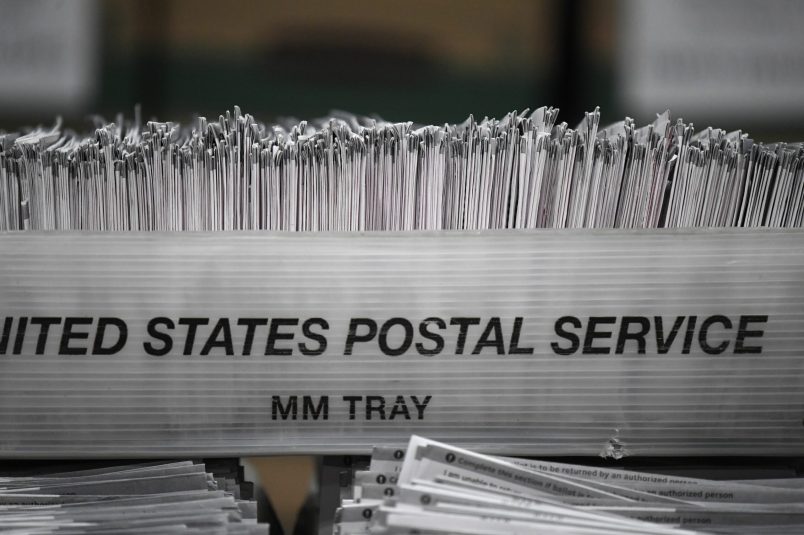When Texas Gov. Greg Abbott (R) signed the state’s big new election bill, SB 1, into law in September — part of a Trumpian wave of new election restrictions across the country — the governor said the bill would help rebuild “trust” in the state’s elections.
“One thing that all Texans can agree [on] and that is that we must have trust and confidence in our elections,” Abbott said. “The bill that I’m about to sign helps to achieve that goal.”
But with Texas’ first-in-the-nation March 1 primary elections rapidly approaching, election officials and activists around the state are worried that the law could disenfranchise some of the state’s most reliable voters. County election officials are scrambling to stave off the worse-case scenarios.
The problems are compounded by what some county officials say is poor communication from the secretary of state’s office: One official told TPM they only learned of a key state database after another clerk spoke out in frustration in a press conference.
“Information is coming fast and it’s a bit confusing,” said Leah Shah, director of communications and voter outreach in Harris County, the most populous county in the state and home to Houston.
“It’s a bit confusing for counties, as it is for voters.”
The main issue, at this point, are the SB 1’s new ID requirements: Voters who qualify to use absentee ballots must now fill in an ID number on their absentee ballot application form.
What’s more, the number must also match the type of number — whether driver’s license, state ID or last four Social Security digits — that officials have on file from when the voter in question first registered. Voters can use any of those options to register, but SB 1 requires them to remember which they chose, potentially decades ago. (Some clerks have advised voters to put down every number they can, for the best chance of a match.)
Elderly voters who may not have access to ID documents, or who can’t recall the number they put down with the state, appear to be especially impacted.
“If they’re in their 70s, 80s, and they’re voting by mail, and they registered to vote 30, 40 years ago — the issue is, what number did they register to vote with?” Grace Chimene, president of the League of Women Voters of Texas, told TPM Monday.
To make matters worse, pre-SB 1 application forms don’t have an ID number field, and are still floating in libraries and other voter-facing locations around the state.
Wave Of Rejections
The confusion is reflected in the high rates of absentee ballot application rejections around the state.
With weeks still to go, the rate of Harris County ballot rejections this year — about 25.6 percent — is significantly higher than it was in 2018, the last off-year election, according to county elections data reviewed by TPM. At least a third of this year’s rejections stemmed from issues directly related to SB 1. In those SB 1-related cases, voters used an outdated form, neglected to write their ID number on the new form, or wrote down an ID number that didn’t match what was on county or state records, Shah said.
The county has a team of dozens of staff and temporary workers reviewing applications and calling voters to fix rejections. Applications must be received by county officials by Feb. 18 for the March 1 primary.
Multiple counties across the state have reported double digit rejection rates, though those rates seem to be coming down as word spreads of the new law’s requirements. Dallas County and Tarrant County, the second- and third-largest counties in the state, respectively, flagged rejection rates as high as 40% last week
“These older voters who are consistent, long-time voters, they’re the ones running into this trouble,” Chimene, of the League of Women Voters, said.
‘We Literally Learned About That In The News’
SB 1’s stumbling blocks have been made worse by a lack of communication from the secretary of state’s office, officials say.
For example, Shah told TPM that Harris County initially wasn’t aware that they could use a state-maintained database to check voters’ ID numbers, and were instead going through “every file we may have” to try and match identifications, Shah said.
They only found out about the state database when the clerk of Travis County, home to Austin, held a press conference to air her complaints with the state, and referenced the database.
“We literally learned about that in the news,” Shah said.
Harris County wasn’t alone. “There were several large counties that are offline that were not aware that they’d have to go beyond their internal systems, and I’m one of them,” elections administrator Chris Davis of Williamson County, north of Austin, told the Texas Tribune.
The secretary of state’s website is still coming to terms with SB 1 itself: Up until Tuesday, when TPM reached out to a spokesperson for comment, the state’s instructions for applying to vote by mail told readers to “Complete Sections 1 through 8” of the application form — even though the post-SB 1 application only has six steps. The site has since been updated.
And the law has plenty more changes in store for counties to deal with.
“There are a number of provisions within this law that we haven’t even gotten to yet, including poll watcher training and things to that effect,” Shah said. “It is causing a bit of confusion and concern that counties will have the ability and resources to correctly implement all of these new laws without impacting voters.”
Chimene, who has also threatened to sue the state over a shortage of voter registration forms, said the turmoil in Texas underlined Congress’ inability to pass voting rights protections.
“I was hoping that the Senate would finally pass something and I would quit having to have these little fights all the time,” she said. “It’s like we’re going back in time, and it’s very hard.



